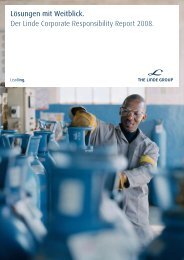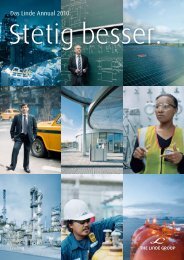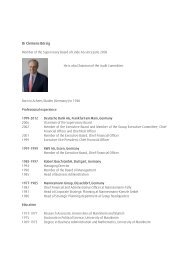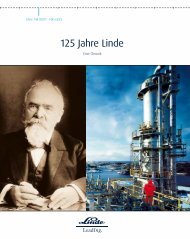The complete history of the development of The - The Linde Group
The complete history of the development of The - The Linde Group
The complete history of the development of The - The Linde Group
Create successful ePaper yourself
Turn your PDF publications into a flip-book with our unique Google optimized e-Paper software.
Currency reform and economic upturn<br />
At <strong>the</strong> time <strong>of</strong> <strong>the</strong> currency reform <strong>of</strong> 1948, when <strong>the</strong> course was<br />
set for <strong>the</strong> post-war economic upturn and <strong>the</strong> new prosperity, <strong>the</strong><br />
<strong>Linde</strong> Company was already back on solid ground. In its opening<br />
balance sheet dated June 21, 1948 <strong>the</strong> “Gesellschaft für <strong>Linde</strong>’s<br />
Eismaschinen” converted its equity capital 1:1 to DM 34,266,000.<br />
DM 34,000,000 were bearer shares and DM 266,000 nominal<br />
shares with 20x voting rights, which were held for <strong>the</strong> most part<br />
by <strong>the</strong> family to prevent hostile takeovers. Reserves <strong>of</strong> nearly<br />
DM 22 million were also built.<br />
<strong>The</strong> home <strong>of</strong>fice in Wiesbaden, which had served primarily<br />
as <strong>the</strong> head design <strong>of</strong>fice for Department A (refrigeration<br />
machines) since Carl von <strong>Linde</strong>’s return to Munich and <strong>the</strong><br />
establishment <strong>of</strong> Department B (gas liquefaction and separation),<br />
received a new administration building and <strong>the</strong> status <strong>of</strong> main<br />
administration.<br />
Economic miracle: not all industries benefited<br />
Fortunes at <strong>the</strong> different departments <strong>of</strong> <strong>the</strong> company did not<br />
all rise at <strong>the</strong> same rate after <strong>the</strong> war. <strong>The</strong> Höllriegelskreuth<br />
facilities engineering department received many orders even<br />
before <strong>the</strong> currency reform, primarily from abroad, in particular<br />
for “pure nitrogen plants as well as for <strong>the</strong> same in connection<br />
with coke oven gas separation plants (especially for Belgium,<br />
Spain and Italy),” according to a report to <strong>the</strong> Supervisory<br />
Board.<br />
<strong>The</strong> oxygen and acetylene works, which had been operated<br />
toge<strong>the</strong>r with IG Farben until 1945, had a more difficult time<br />
<strong>of</strong> it, because, <strong>of</strong> course, IG Farben was dissolved by <strong>the</strong> Allies.<br />
It took some time before <strong>the</strong> <strong>Linde</strong> Company was able to take<br />
over its old gas works under its own control once again. At first<br />
it produced “primarily for <strong>the</strong> foreign troops.” After <strong>the</strong> currency<br />
reform, sales <strong>of</strong> oxygen and acetylene “rose remarkably”<br />
(report in <strong>the</strong> opening balance sheet <strong>of</strong> 1949), and so from 1948<br />
1951 1952<br />
First color television transmissions sent by CBS in <strong>the</strong> USA.<br />
Dr.-Ing. Hugo Ombeck (1886 –1963)<br />
Dr.-Ing. Hugo Ombeck, chairman <strong>of</strong> <strong>the</strong><br />
Executive Board from 1954 to 1961.<br />
Hugo Ombeck joined <strong>the</strong> “Gesellschaft für<br />
<strong>Linde</strong>’s Eismaschinen” in January 1913<br />
as a young engineer in Department A<br />
(refrigeration machines). After World War I<br />
he became <strong>the</strong> manager <strong>of</strong> <strong>the</strong> sales<br />
department (July 1, 1919) and received<br />
power <strong>of</strong> attorney in 1924. In 1928 he<br />
became a deputy member and in 1929 a<br />
regular member <strong>of</strong> <strong>the</strong> Executive Board.<br />
He became chairman <strong>of</strong> <strong>the</strong> Executive<br />
Board on October 1, 1954.<br />
Ombeck was an old-style “general director”<br />
– self-confident and quick to make<br />
decisions. At <strong>the</strong> same time, during his<br />
period in <strong>of</strong>fice he supported <strong>the</strong> reorganization<br />
<strong>of</strong> <strong>the</strong> Sürth and Güldner<br />
plant groups according to <strong>the</strong> American<br />
model.<br />
American Edward Teller invents<br />
<strong>the</strong> hydrogen bomb.<br />
Ombeck left <strong>the</strong> existing structures at<br />
<strong>the</strong> top <strong>of</strong> <strong>the</strong> company, with <strong>the</strong> two<br />
main locations <strong>of</strong> Höllriegelskreuth and<br />
Wiesbaden, untouched and made possible<br />
a harmonious transition from <strong>the</strong><br />
second generation <strong>of</strong> <strong>the</strong> <strong>Linde</strong> family<br />
to <strong>the</strong> third in <strong>the</strong> management <strong>of</strong> <strong>the</strong><br />
companies.<br />
In 1961, at <strong>the</strong> age <strong>of</strong> 75, Hugo<br />
Ombeck retired from <strong>the</strong> position <strong>of</strong><br />
chairman <strong>of</strong> <strong>the</strong> executive board, which<br />
was taken over by Dr. Johannes Wucherer,<br />
a grandson <strong>of</strong> Carl von <strong>Linde</strong>. Ombeck<br />
died on December 27, 1963 in Wiesbaden.<br />
49


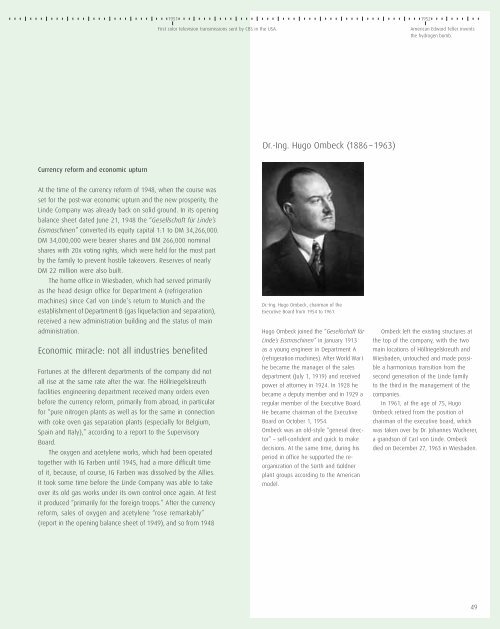
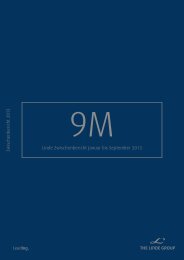
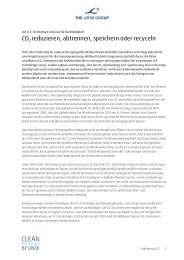

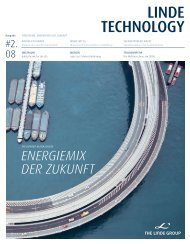
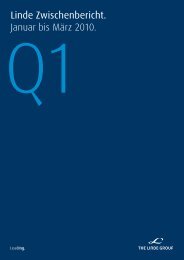
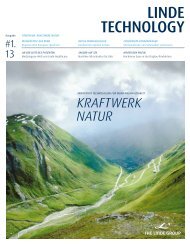
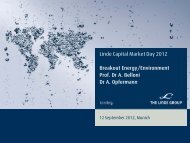
![[41] Anteilsbesitzliste des Linde Konzerns und ... - The Linde Group](https://img.yumpu.com/8356102/1/184x260/41-anteilsbesitzliste-des-linde-konzerns-und-the-linde-group.jpg?quality=85)
![[41] Anteilsbesitzliste des Linde Konzerns und ... - The Linde Group](https://img.yumpu.com/8356076/1/184x260/41-anteilsbesitzliste-des-linde-konzerns-und-the-linde-group.jpg?quality=85)
